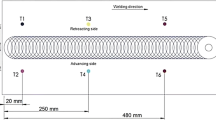Abstract
Friction stir welding (FSW) is a suitable method for producing dissimilar joints. This study investigated the electrical and mechanical properties of friction stir welded aluminium-copper joints that were manufactured at a comparatively high welding speed of 500 mm/min. For this purpose, the specimens welded in a butt joint configuration were subjected to metallographic analyses, tensile testing, electrical resistance measurements and also combined fatigue and resistance testing. The tensile strength of the examined specimens was 110 MPa, which is similar to the aluminium-base material strength. The electrical resistance of the friction stir welds was between the electrical resistances of the base materials copper and aluminium. The fatigue tests were discontinued after 2 × 106 cycles. Fatigue testing resulted in a survival probability of 90% for this number of cycles and a maximum stress of 49 MPa at a stress ratio of R = 0.1. The electrical resistance of the examined joints remained practically constant during the fatigue test until specimen failure occurred.










Similar content being viewed by others
References
Braunovic M, Myshkin NK, Konchits VV (2007) Electrical contacts: fundamentals, applications and technology. Electrical and computer engineering, vol 132. Taylor & Francis distributor, Boca Raton
Khodir SA, Ahmed MMZ, Ahmed E, Mohamed SMR, Abdel-Aleem H (2016) Effect of intermetallic compound phases on the mechanical properties of the dissimilar Al/Cu friction stir welded joints. J Mater Eng Perform 25(11):4637–4648. https://doi.org/10.1007/s11665-016-2314-y
Xue P, Xiao BL, Ni DR, Ma ZY (2010) Enhanced mechanical properties of friction stir welded dissimilar Al–Cu joint by intermetallic compounds. Mater Sci Eng A 527(21–22):5723–5727. https://doi.org/10.1016/j.msea.2010.05.061
Barekatain H, Kazeminezhad M, Kokabi AH (2014) Microstructure and mechanical properties in dissimilar butt friction stir welding of severely plastic deformed aluminum AA 1050 and commercially pure copper sheets. J Mater Sci Technol 30(8):826–834. https://doi.org/10.1016/j.jmst.2013.11.007
Zhang Q, Gong W, Liu W (2015) Microstructure and mechanical properties of dissimilar Al–Cu joints by friction stir welding. Trans Nonferrous Metals Soc China 25(6):1779–1786. https://doi.org/10.1016/S1003-6326(15)63783-9
Mishra RS, De PS, Kumar N (2014) Friction stir welding and processing: science and engineering. Springer International Publishing, Cham
Xue P, Ni DR, Wang D, Xiao BL, Ma ZY (2011) Effect of friction stir welding parameters on the microstructure and mechanical properties of the dissimilar Al–Cu joints. Mater Sci Eng A 528(13–14):4683–4689. https://doi.org/10.1016/j.msea.2011.02.067
Le Jolu T, Morgeneyer TF, Denquin A et al (2015) Fatigue lifetime and tearing resistance of AA2198 Al–Cu–Li alloy friction stir welds: effect of defects. Int J Fatigue 70:463–472. https://doi.org/10.1016/j.ijfatigue.2014.07.001
Raut A, Kridli GT, Mallick PK (2005) Fatigue of Friction-Stir Welded Joints in Aluminum Tailor Welded Blanks. SAE Technical Paper 2005-01-1253. https://doi.org/10.4271/2005-01-1253
Deutsches Institut für Normung e.V (2013) Aluminium und Aluminiumlegierungen - Chemische Zusammensetzung und Form von Halbzeug - Teil 3: Chemische Zusammensetzung und Erzeugnisformen (DINEN 573–3). Beuth Verlag GmbH. Berlin
Deutsches Institut für Normung e.V (2014) Kupfer und Kupferlegierungen - Platten, Bleche und Bänder aus Kupfer für die Anwendung in der Elektrotechnik (DIN EN 13599). Beuth Verlag GmbH. Berlin
Li X, Zhang D, Qiu C et al (2012) Microstructure and mechanical properties of dissimilar pure copper/1350 aluminum alloy butt joints by friction stir welding. Trans Nonferrous Metals Soc China 22(6):1298–1306. https://doi.org/10.1016/S1003-6326(11)61318-6
Muthu MFX, Jayabalan V (2015) Tool travel speed effects on the microstructure of friction stir welded aluminum–copper joints. J Mater Process Technol 217:105–113. https://doi.org/10.1016/j.jmatprotec.2014.11.007
Celik S, Cakir R (2016) Effect of friction stir welding parameters on the mechanical and microstructure properties of the Al-Cu butt joint. Metals 6(6):133. https://doi.org/10.3390/met6060133
Eslami N, Harms A, Deringer J, Fricke A, Böhm S (2018) Dissimilar friction stir butt welding of aluminum and copper with cross-section adjustment for current-carrying components. Metals 8(9):661–671. https://doi.org/10.3390/met8090661
Braunovic M, Alexandrov N (1994) Intermetallic compounds at aluminum-to-copper electrical interfaces: effect of temperature and electric current. IEEE Trans Comp Packag Manuf Technol A 17(1):78–85. https://doi.org/10.1109/95.296372
Balle F, Huxhold S, Wagner G, Eifler D (2011) Damage monitoring of ultrasonically welded aluminum/CFRP-joints by electrical resistance measurements. Procedia Eng 10:433–438. https://doi.org/10.1016/j.proeng.2011.04.074
Author information
Authors and Affiliations
Corresponding author
Additional information
Publisher’s note
Springer Nature remains neutral with regard to jurisdictional claims in published maps and institutional affiliations.
Recommended for publication by Commission III - Resistance Welding, Solid State Welding, and Allied Joining Process
Rights and permissions
About this article
Cite this article
Eslami, N., Harms, A., Henke, B. et al. Electrical and mechanical properties of friction stir welded Al-Cu butt joints. Weld World 63, 903–911 (2019). https://doi.org/10.1007/s40194-019-00719-y
Received:
Accepted:
Published:
Issue Date:
DOI: https://doi.org/10.1007/s40194-019-00719-y




